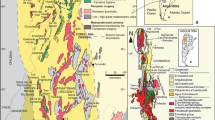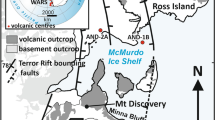Abstract
We describe the evolution of Concepción volcano by integrating regional geology, eruptive activity, morphology, stratigraphy, petrology, structure and active deformation data. This Nicaraguan volcano is set close to the back limb of the northwest-trending Tertiary Rivas anticline, a regional structure that bounds the southwest side of Lake Nicaragua. Concepción rises 1,600 m above a 1-km-thick sequence of Quaternary lacustrine mud-stones. There is no record of volcanism in the lake prior to Concepción. In addition, the only nearby volcano, Maderas volcano, has not deposited material on Concepción because of the trade winds. Thus, Concepción (and Made ras, too) can be considered as pristine volcanic environments, unaffected by other centres. A topographic rise forms an annulus 20 km in diameter around the cone. The rise is created by thrust-related folds at the western base, where the trade winds have accumulated a thick sequence of tephra, and by mud diapirs at the eastern base where only lake mudstones are present. Four magmatic-eruptive episodes exist in the stratigraphic record. The first begins with primitive low-alumina basalt and subsequently evolves to dacitic compositions. The following three episodes begin with high-alumina basalts and evolve only to silicic andesites. The occurrence of the high-alumina basalt after the first episode is indicative of crystal fractionation at lower crustal depths. The first episode may be associated with a compressive phase of volcano evolution. In this phase, the edifice load compresses substrata, allowing a longer magma residence time and differentiation in a shallow reservoir (possibly located at the density contrast between the lake sediments and the Tertiary flysch). During the next three episodes the weak sediments below the volcano started to rupture and yield under its increasing load, beginning a thrusting/diapiring phase of volcano evolution. Because of outward thrusting, vertical and horizontal stresses above the chamber were reduced, allowing magma to erupt more easily and to reach a lesser degree of evolution. If we consider the future evolution of Concepción, the differentiation in the shallow reservoir has probably generated a cumulitic complex, which eventually will start to deform and spread, beginning another, this time plutonic, spreading phase. This phase, which may be beginning now, could allow less evolved magmas to be erupted again. Four components influence the phases of volcano evolution: (1) the regional geology that is the boundary condition of the environment, (2) the substrata rheology that controls deformation, (3) the load of the volcanic edifice and (4) the magma, which provides the input of mass and energy. Our model of volcanic evolution suggests that Concepción is a complex geologic environment. The volcanic activity, tectonics and hazards can only be constrained through a complete knowledge of the many components of this environment.
Similar content being viewed by others
References
Baker DR, Eggler DH (1983) Fractionation paths of Atka (Aleutians) high-alumina basalts; constraints from phase relations. J Volcanol Geotherm Res 18:387–404
Borgia A (1994) The dynamic basis of volcanic spreading: J Geophys Res 99:17791–17804
Borgia A, Burr J, Montero LD, Morales W, Alvarado GE (1990) Fault propagation folds induced by gravitational failure and slumping of the Central Costa Rica Volcanic Range: implications for lame Terrestrial and Martian volcanic edifices. J Geophys Res 95:14357–14382
Borgia A, Ferrari L, Pasquare G (1992) Importance of gravitational spreading in the tectonic and volcanic evolution of Mount Etna. Nature 357:231–235
Borgia A, Lanari R, Sansosti E, Tesauro M, Berardino P, Fornaro G, Neri M, Murray JB (2000a) Actively growing anticlines beneath Catania from the distal motion of Mount Etna’s decollement measured by SAR interferometry and GPS. Geophys Res Lett 27:3409–3412
Borgia A, Delanev PT, Denlinger RP (2000b) Spreading volcanoes. Annu Rev Earth Planet Sci 28:539–570
Carr MJ, Rose WI, Stoiber RE (1982) Central America. In: Thorpe RS (ed) Andesites: orogenic andesites and related rocks. Wiley, New York, pp 149–166
Clague DA, Denlinger RP (1994) Role of olivine cumulates in destabilizing; the flanks of Hawaiian volcanoes. Bull Volcanol 56:425–434
Cruden AR (1989) The structure of South western Nicaragua: a preliminary assessment. Swedish Geological, SGAB International AB, Uppsala, Sweden, pp 1–28
de Boer J (1979) The outer arc of the Central American orogen (oceanic basement complexes of the Nicoya and Santa Elena peninsulas). Tectonophysics 56:221–259
Ehrenborg J (1996) A new stratigraphy for the Tertiary volcanic rocks or the Nicaraguan highland. Geol Soc Am Bull 108:830–842
Ferrey CJ, Willams RL (1971) Geologia de la Isla de Ometepe. Archivo Accesible Informe 7. Catastro e Inventario de Recursos Naturales, Managua, Nicaragua, pp 1–20
Fink JH, Griffiths RW (1998) Morphology, eruption rates, and rheology of lava domes: Insight from laboratory models. J Geophys Res 103:527–545
Bates RL, Jackson JA (eds) (1987) Glossary of geology.. American Geological Institute, Alexandria, Virginia, pp 1–1025
GVN (1986) Bulletin of the global volcanism network. Smithsonian Institution 11, p 5
GVN (1993) Bulletin of the global volcanism network. Smithsonian Institution 18, p 3
GVN (2000) Bulletin of the global volcanism network. Smithsonian Institution 25, p 2
Hawkesworth CJ, Blake S, Evans P, Huges R, Macdonald R, Thomas LE, Turner SP, Zellmer G (2000) Time scales of crystal fractionation in magma chambers-integrating physical isotopic and geochemical perspectives. J Petrol 41:991–1006
Korn H, Martin H (1954) The Messum igneous complex in southwest Africa. Geol Soc S Afr Trans 57:83–132
Leica, 1993 User guide to SKI GPS processing software. Leica, Swizerland
McBirney AR, Williams H (1965) The volcanic history of Nicaragua. University of California Publications in Geological Sciences 55, pp 1–65
McDermott F, Hawkesworth C (1991) Th, Pb, and Sr isotope variations in vounsz island arc volcanics and oceanic sediments. EPSL 104:1–15
Merle O, Nickelsen RP, Davis GH, Gourlay P (1993) Relation of thin-skinned thrusting of Colorado Plateau strata in southwestern Utah to Cenozoic maematism. Geol Soc Am Bull 105:387–398
Merle O, Vendeville B (1995) Experimental modelling of thin-skinned shortening around masimatic intrusions. Bull Volcanol 57:33–43
Merle O, Borgia A (1996) Scaled experiments of volcanic spreading. J Geophys Res 101:13805–13817
Navarro M (1996) Informe sobre los lahares de Volcán Concepción en octubre 1996. INETER Archive, Managua, Nicaragua, pp 1–10
Reeves F (1925) Shallow folding and faulting around the Bearpaw Mountains. Am J Sci 10:187–200
Richey JE (1961) Scotland: the Tertiary volcanic districts, 3rd edn. (Revised by MacGragor AG, Anderson FW). Dept Sci Ind Res Geol Surv and Museum Edinburgh, pp 1–199
Ryan MP (1988) The mechanics and three-dimensional internal structure of active magmatic systems: Kilauea volcano, Hawaii. J Geophys Res 93:4213–4248
Seyfried H, Astorga A, Amann H., Calvo C, Kolb W, Schmitt H, Jutta H (1991) Anatomy of an evolving island arc: tectonic and eustatic control in the South Central American fore-arc area. In: Macdonald, DIM (ed) Sedimentation, tectonics and eustacy: sea level changes at active margins. Special Publication of the International Association of Sedimentolosists 12. Blackwell, Oxford, pp 217–240
Simkin T, Siebert L (1995) Volcanoes of the world, 2nd edn. Geoscience Press Inc, Tuscon, Arizona, pp 1–349
Turner S, Evans P, Hawkesworth C (2001) Ultrafast source-to-surface movement of melt at island arcs from 226Ra-230Th systematics. Science 292:1363–1366
van Bemmelen RW (1949) The geology of Indonesia: General geology of Indonesia and adjacent archipelagos, vol 1A. Government Printing Office, The Hague, Netherlands, pp 1–732
van Wyk de Vries B (1986) Volcanic and seismic hazard on Isla de Ometepe, Lago de Nicaragua, Nicaragua. INETER archives, Managua, Nicaragua, pp 1–35
van Wyk de Vries B (1993) Tectonics and magma evolution of Nicaraguan volcanic systems. PhD Thesis, Open University, Milton Keynes, pp 1–328
van Wyk de Vries B, Borgia A (1996) The role of basement in volcano deformation. In: McGuire WC, Jones AP, Neuberg J (eds) Volcano instability on the earth and other planets. Geol Soc Lond Spec Publ 110:95–110
van Wyk de Vries B, Francis PW (1997) Catastrophic collapse at stratovolcanoes induced by gradual volcanic spreading. Nature 387:387–390
van Wyk de Vries B, Merle O (1996) The effect of volcano constructs on rift fault patterns. Geology 24:643–646
van Wyk de Vries B, Merle O (1998) Extension induced by volcanic loading in regional strike-slip zones. Geology 26:983–986
van Wyk de Vries B, Kerle N, Petley D (2000) A sector-collapse forming at Casita volcano, Nicaragua. Geology 28:167–170
van Wyk de Vries B, Self S, Francis PW, Kesthelyi L (2001) A spreading origin for the Socompa Debris avalanche. J Volcanol Geotherm Res 105:255–247
Walker JA (1984) Volcanic rocks from the Nejapa and Grenada cinder cone alignments, Nicaragua, Central America. J Petrol 25:299–342
Weinberg RF (1992) Neotectonic development of Nicaragua: Tectonics 11:1010–1017
Weyl R (1980) Geology of Central America. Borntraeger, Berlin, pp 1–371
Author information
Authors and Affiliations
Corresponding author
Additional information
Published online: 20 February 2003
Editorial responsibility: R. Cioni
Rights and permissions
About this article
Cite this article
Borgia, A., van Wyk de Vries, B. The volcano-tectonic evolution of Concepción, Nicaragua. Bull Volcanol 65, 248–266 (2003). https://doi.org/10.1007/s00445-002-0256-8
Received:
Accepted:
Issue Date:
DOI: https://doi.org/10.1007/s00445-002-0256-8




